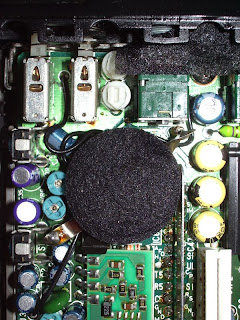 Memory fix
Memory fix
Six months ago I bought an old Kenwood TH-205 on eBay for spares or repair. I got it working, managed to find a new replacement NiCad battery pack for it and built a drop-in charger for it for a total cost of well under £20. The backup battery had died so the memories didn’t work and the radio wouldn’t even remember the frequency it was last used on, but I was pleased just to have got it working and I was afraid the replacement would be an expensive part the cost of which couldn’t be justified.
Today I decided to have a look and see if the backup battery could be replaced. I wasn’t sure where the backup battery was, but I guessed it might be hidden under a foam pad in the centre of the circuit board. I had a peek and was pleased to find that it was a CR2032 3V lithium button cell. However it wasn’t your regular CR2032 cell that you can buy in stores, but one with solder tags spot welded to each side.
I looked on eBay, but although this turned up zillions of sellers of the regular cells at prices from five for a pound, no-one had the version with solder tags. I looked to see if I could fit a cell holder into the radio but the PCB mount one I had was quite a bit thicker than the cell itself and there was insufficient space for it.
I tried a Google search and Digikey had a CR2032 with solder tags for £1.17 a time, but there was a £12 shipping charge which made it uneconomic. The cost of the repair needed to be proportionate to what I paid for the radio.
So I decided to try taping wires to a regular CR2032 cell. I doubt that I could solder to it, and that probably isn’t a good idea anyway. I had a CR2032 which came in a kit I purchased recently but haven’t started to build yet. It was new and sealed in its packing so I thought I would use that. It was a good job I decided to check the voltage after taping the wires to it, in order to verify they were making good contact, because it was as dead as a dodo! Even the one I took out of the radio showed more signs of life, as it acts as a capacitor and charges up a little bit when the battery power is turned on.
So it’s back to eBay to order a couple of replacement cells, one for the Kenwood and one for the kit I haven’t yet built.














I had the same problem with a Kenwood 215A and was able to solder the leads to the battery using as low of heat as possible on my soldering iron. It has been working fine now for over a year.